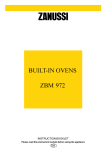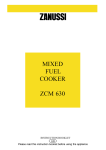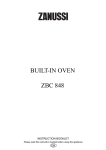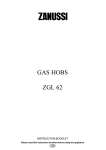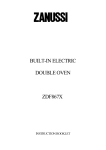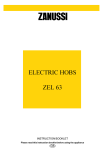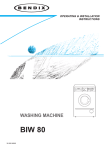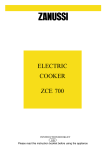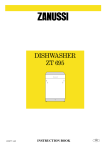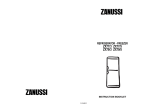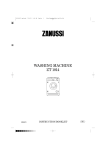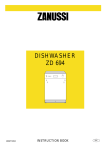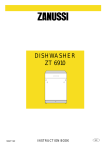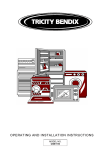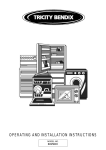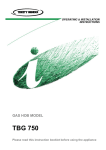Download Zanussi ZCE 630 Instruction Manual
Transcript
ELECTRIC COOKER ZCE 630 INSTRUCTION BOOKLET GB Please read this instruction booklet before using the appliance Important Safety Information You MUST read these warnings carefully before installing or using the appliance. If you need assistance, contact our Customer Care Department on 08705 727727 Installation l l l l This cooker must be installed by qualified personnel, according to the manufacturers instructions and to the relevant British Standards. This cooker is heavy. Take care when moving it. Remove all packaging before using the cooker. Ensure that the electrical supply complies with the type stated on the rating plate. Do not attempt to modify the cooker in any way. l Service l Child Safety l l l This cooker is designed to be operated by adults. Do not allow children to play near or with the cooker. The cooker gets hot when it is in use. Children should be kept away until it has cooled. Children can also injure themselves by pulling pans or pots off the cooker. During Use l l l l l l l l l l l l 2 This cooker is intended for domestic cooking only. It is not designed for commercial or industrial purposes. Do not use this cooker if it is in contact with water. Do not operate the cooker with wet hands. Ensure the control knobs are in the OFF position when not in use. When using other electrical appliances, ensure the cable does not come into contact with the hot surfaces of the cooker. Never use the ceramic hob as a working space. Do not store things on the ceramic hob. Never use plastic or aluminium foil dishes on the ceramic hob. Unstable or misshapen pans should not be used on the ceramic hob as unstable pans can cause an accident by tipping or spillage. Never leave the cooker unattended when cooking with oil and fats. The ceramic hob is shockproof, but not unbreakable! Hard or pointed objects falling from a height can damage the hob. If scratches or cracks are noticed, disconnect the cooker from the electrical supply and call you nearest Zanussi Service Force Centre. This cooker should be kept clean at all times. A build-up of fats or foodstuffs could result in a fire. Never use plastic dishes in the oven. Never line any part of the oven with aluminium foil. Always ensure that the oven vent which is located at the centre back of the hob is left unobstructed to ensure ventilation of the oven cavity. Perishable food, plastic items and areosols may be affected by heat and should not be stored above the cooker. This cooker should only be repaired or serviced by an authorised Service Engineer and only genuine approved spare parts should be used. Environmental Information l l After installation, please dispose of the packaging with due regard to safety and the environment. When disposing of an old appliance, make it unusable, by cutting off the cable. Keep this instruction book for future reference and ensure it is passed on to any new owner. Guide to Use the instructions The following symbols will be found in the text to guide you throughout the Instructions: Safety Instructions F Step by step instructions for an operation Hints and Tips Environmental Information This appliance is manufactured according to the following EEC directives: 73/23 EEC - 90/683 EEC - 93/68 EEC 89/336 EEC current edition. Contents For the User Important Safety Information Description of the Cooker Control Panel Operation Using the ceramic glass hob Electric Oven 24 hour Clock and Timer Using the Oven Before the First Use of the Cooker Using the Conventional Oven Cooking Chart Using the Fan Oven & Defrosting function Fan Oven Cooking Chart Defrosting Chart Grilling Cleaning the Ceramic Hob Cleaning the Oven 2 3 4 5 6 7 8 10 10 11 12 13 14 14 15 16 17 Service and Spare Parts Something not working Guarantee Conditions 18 18 19 For the Installer Important Safety Requirements Instructions for the Installer Electrical connections 22 22 23 Oven Door Protection Device All our appliances comply with the European safety standards. Nevertheless, in order to ensure the highest safety level, and avoid small children to be exposed to the heat when the appliance is operated, it is possible to fit a special ptotection device to the oven door. This device can be purchased in our Service Force Centres, specifying the relevant code (35791) and the Product No. shown on the rating plate. Description of the Cooker Residual heat indicators Back right cooking zone (double circuit) Back left cooking zone Front left cooking zone (double circuit) Control panel Front right cooking zone A U T O TIMER Shelf Oven door Storage drawer 3 Control Panel 2 FRONT LEFT BACK LEFT BACK RIGHT FRONT RIGHT OVEN FUNCTION TEMPERATURE OVEN PROGRAMMER MAINS ON A U T O THERMOSTAT TIMER 1 3 4 5 6 7 9 8 Storage Drawer 1. 2. 3. 4. 5. 6. 7. 8. 9. Oven Thermostat Pilot Light Cooker Operation Pilot Light Front left cooking zone control knob Back left cooking zone control knob Back right cooking zone control knob Front right cooking zone control knob Oven function control knob Oven thermostat control knob 24 hour clock and Programmer The Oven Cavity The storage drawer is located underneath the oven cavity. During cooking the storage drawer may become hot if the oven is on high for a long period of time, therefore flammable materials such as oven gloves, tea towels, plastic aprons etc. should not be stored in the drawer. Oven accessories such as baking sheets, will also become hot, therefore care should be taken when removing these items from the drawer whilst the oven is in use or still hot. Accessories Oven Light Grill element Grill/roasting pan Grill trivet Removable handles Oven fan 4 Operation Ceramic hob cooking zones Control knob for normal cooking zone To switch on a cooking zone, turn the relevant control knob clockwise to the required heat setting. The control knob is numbered 0 - 3 0 3 0 - OFF 3 - Maximum. The hob has two types of cooking zones: 1 2 normal cooking zones (back left and front right) 2 We recommend the plates are switched to maximum (3) for a short while to boost the cooking zone, and then adjusted to the required setting. 2 double circuit cooking zones (back right and front left) The back right and front left cooking zones have two heating elements. FO 2086 Control knob for double circuit cooking zone - To switch on the smaller circular cooking zone, turn the relevant control knob clockwise to the required heat setting. - To switch on both heating elements, turn the control knob clockwise to maximum heat setting (3) then turn the knob further to nearly reach the "0" symbol. You will hear a "click" and the wider cooking zone will switch on. Then turn back the knob to position 3 and adjust it to the required heat setting. Please consider that the two heating elements will now operate together, giving a higher power output than a normal cooking zone. 0 1 3 2 Residual heat indicators The hob is fitted with four residual heat indicators corresponding to each cooking zone. The corresponding indicator will remain on until the temperature falls below 30° C, even after the cooking zone is switched off. When switch on a cooking zone, a short buzzing may be heard. This is quite normal and does not affect the hob operation in any way. Suggestions for the correct setting of the cooking zones are given in the following table. OFF 0 Very Gentle Simmering vegetables Fish in its own juice Gentle 1 Simmering potatoes or soups Slow Boiling large quantities of food, stews and soups Medium 2 Slow frying, making a roux High Fast frying of meat or fish Fast 3 Rapid heating up of fat or water 5 Using the ceramic glass hob Ceramic glass surface The glass is hard, and has been tempered to withstand heat, cold and temperature shocks. But like all glass it is sensitive to impact. Do not stand on the ceramic glass surface. If scratches or cracks are noticed, disconnect the cooker from the electrical supply and call you nearest Zanussi Service Force Centre. Keep all objects and materials which can melt away from the cooking surface, e.g. plastics, aluminium foil. Care should be taken when preparing food or drinks containing sugar. If anything of this nature accidentally comes into contact with the ceramic surface it must be scraped off immediately while stlll hot and wiped away to avoid damage to the surface. Energy consumption To save energy, you should . . - use only cooking and frying utensils with smooth, flat bases. - place pots and pans in position before switching on the cooking zone. - wherever possible, cover pots and pans with a lid. - switch off the cooking zone a few minutes before the end of the cooking time, in order to make use of the residual heat. - use the residual heat of the cooking zones for keeping food warm or for melting. - position pots and pans centrally on the cooking zones. Saucepans and frying pans Saucepans and frying pans should not be smaller than the cooking zone, and preferably not more than 10-15 mm larger than the diameter of the cooking zone. Always use cooking and frying utensils with smooth, flat bases. The bases should always be clean and dry. Cook with a lid in place. Check that the bases of utensils are smooth and undamaged; bases with burrs and sharp edges will scratch the ceramic glass surface. To avoid scratching or damaging the ceramic cooking surface, pots and pans should be moved on the plate by lifting them, and not by sliding. Utensils with aluminium and copper bases can leave behind metallic discolorations which can only be removed with difficulty or sometimes not at all. 6 Electric Oven Oven Function Control Knob 0 Conventional cooking - The heat comes from both the top and bottom element, ensuring even heating inside the oven. Bottom heating element - The heat comes from the bottom of the oven only Top heating element - The heat comes from the top of the oven only Grill - The heat comes only from the top element FO 2494 Fan cooking - This function allows you to roast or roast and bake simoultaneously using any shelf. Defrost setting -This function assists in thawing of frozen food. Thermostat Control Knob 100 50 Turn the thermostat control knob clockwise to select temperatures between 50°C and 250°C (MAX). 0 150 The mains on light will come on when a heating element is on. 20 Mains on Light FO 0877 Thermostat Control Light The thermostat control light will come on when the thermostat control knob is turned. The light will remain on until the correct temperature is reached. It will then cycle on and off to show the temperature is being maintained. 7 24 hour Clock and Timer Cookpot symbol Minute minder Cooking duration End of cooking time Auto symbol Manual function Cookpot symbol - This will be displayed when a program is in operation. A U T O A U T O TIMER Time setting Auto symbol - This will be displayed when the oven has been programmed for automatic operation. Programming controls Time setting knob - Turn it clockwise and hold it in the turned position to increase the time setting. Turn it anticlockwise and hold it in the turned position to decrease the time setting. The countup or count-down speed increases the longer the knob is held in the turned position. The electronic timer can indicate the time of day, operate as a minute minder and automatically operate the oven. Before the oven can be operated, the time of day must be set on the electronic timer. Please note that this is a 24 hour clock. For example, 2pm is shown as 14:00. In case of loss of power, all the settings (time of day, set program or program in operation), will be cancelled. When the power is restored, the numbers on the display will flash, and the timer has to be reset. TIMER F TO SET THE TIME OF DAY Press button , release the button, then turn the time setting knob until the correct time of day is displayed. FTO SET THE MINUTE MINDER Press button , release the button, then turn the setting time knob until the duration time is displayed (maximum 23 hours, 59 minutes). Our diagram shows the timer set for 45 minutes. After a few seconds the time of day will show in the display. To check the number of minutes remaining, press the button. At the end of the timed period an alarm will sound. To switch off the alarm press button 8 . TIMER F MANUAL FUNCTION Press button to set the oven for manual function. TIMER F TO SET THE TIMER TO SWITCH OFF ONLY This is useful if you want to begin cooking immediately but have the oven switch off automatically. 1. Set the oven function control knob and the thermostat control knob on the required settings. 2. Place food in the oven. 3. Press button , release the button, then turn the time setting knob until the required cooking duration is displayed. Our diagram shows the timer set for 30 minutes. At the end of the cooking time the oven will switch off, an alarm will sound. To switch off the alarm press button . Ensure the oven function control knob and the thermostat control knob are in the OFF position. F TIMER TO SET THE TIMER TO SWITCH THE OVEN ON AND OFF 1. Ensure the clock is showing the right time of day. 2. Carry out steps 1, 2 and 3 as explained in "To set the timer to switch off only". TIMER 3. Press button , release the button, then turn the time setting knob until the end cooking time is displayed. Our diagram shows the end cooking time set for 7.00 pm. 4. The oven will switch on and off automatically. The end of cooking will be marked by an acoustic alarm. To switch off the alarm press button . Ensure the oven function control knob and the thermostat control knob are in the OFF position. F TO CANCEL A PROGRAMME Press button . Any set program or program in operation will be cancelled and the timer will revert to manual function. Ensure the oven function control knob and the thermostat control knob are in the OFF position. 9 Before the First Use of the Cooker Remove all packaging, both inside and outside the oven, before using the oven. Before first use, the oven should be heated without food. During this time, an unpleasant odour may be emitted. This is quite normal. F l l Set the electronic programmer to manual function. Switch the oven function control knob to conventional cooking . Set the thermostat control knob to MAX. l Open a window for ventilation. l Allow the oven to run empty for approximately 45 minutes. This procedure should be repeated with the fan cooking and grill function for approximately 5-10 minutes. Using the ceramic hob for the first time The cooking surface should be cleaned before use to remove any traces of the production process. F Wipe the ceramic surface and frame with a damp cloth using warm water to which a little washing up liquid has been added, and wipe dry. l Heating up for the first time F To check the cooking zones, briefly switch each one on. Using the Oven Always cook with the oven door closed. Stand clear when opening the drop down oven door. Do not allow it to fall open support the door using the door handle, until it is fully open. The oven has four shelf levels, and is supplied with two shelves. The shelf positions are counted from the bottom of the oven as shown in the diagram. It is important that these shelves are correctly positioned as shown in the diagram. Do not place cookware directly on the oven base. Hints and Tips Condensation and steam When food is heated it produces steam in the same way as a boiling kettle. The oven vents allow some of this steam to escape. However, always stand back from the oven when opening the oven door to allow any build up of steam or heat to release. If the steam comes into contact with a cool surface on the outside of the oven, e.g. a trim, it will condense and produce water droplets. This is quite normal and is not a fault with the oven. To prevent discolouration, regularly wipe away condensation and also soilage from surfaces. 4 3 2 1 Cookware Use any oven proof cookware which will withstand temperatures of 250°C. Baking trays, oven dishes, etc. should not be placed directly against the grid covering the fan at the back of the oven, or placed on the oven base. Do not use baking trays larger than 30 cm x 35 cm (12 in x 14 in) as they will restrict the circulation of heat and may affect performance. The effects of dishes on cooking results Dishes and tins vary in their thickness, conductivity, colour, etc. which affects the way they transmit heat to the food inside them. A Aluminium, earthenware, oven glassware and bright shiny utensils reduce cooking and base browning. B Enamelled cast iron, anodized aluminium, aluminium with non-stick interior and coloured exterior and dark, heavy utensils increase cooking and base browning. 10 Using the Conventional Oven When using this setting, heat comes from both the top and bottom elements. This allows you to cook on a single level and is particularly suitable for dishes which require extra base browning such as pizzas, quiches and flans. Gratins, lasagnes and hotpots which require extra top browning also cook well in the conventional oven. This form of cooking gives you the opportunity to cook without the fan in operation. to Use the F How Conventional Oven 1. Turn the oven function control knob to the required cooking function ( ). 2. Turn the thermostat control to the required temperature. Top oven element only This function is suitable for finishing cooked dishes, e.g. lasagne, shepherds pie, cauliflower cheese etc. Hints and Tips The middle shelf position allows for the best heat distribution. To increase base browning simply lower the shelf position. To increase top browning, raise the shelf position. The material and finish of the baking trays and dishes used will affect base browning. Enamelware, dark, heavy or non-stick utensils increase base browning, while oven glassware, shiny aluminium or polished steel trays reflect the heat away and give less base browning. Always place dishes centrally on the shelf to ensure even browning. Stand dishes on suitably sized baking trays to prevent spillage onto the base of the oven and make cleaning easier. Do not place dishes, tins or baking trays directly on the oven base as it becomes very hot and damage will occur. For faster preheating use the fan oven function to preheat the oven until the oven indicator neon goes out, then swich the selector to the conventional oven setting. Single level cooking gives best results. If you require more than one level cooking use the fan oven function. Bottom oven element only This function is particularly useful when blind-baking pastry. It may also be used to finish off quiches or flans to ensure the base pastry is cooked through. THINGS TO NOTE l The oven light will come on when the oven function control knob is set. l The thermostat control light will remain on until the correct temperature is reached. It will then cycle on and off to show that temperature is being maintained. 11 Cooking Chart - Conventional Oven Food Thermostat Runner Time Position Biscuits, cookies 170-200 3 25-20 min. Bread, yeast doughs 200-230 2 35-45 min. Casseroles 140-170 2 90-180 min. Small cakes 170-180 2 18-25 min. Madeira 160-180 2 60-90 min. Rich fruit 130-140 2 60-150 min. Choux pastry, eclairs 200-230 2 30-35 min. Fish 200-230 2 or 3 20-40 min. Fruit pies, plate tarts, crumbles 180-210 2 50-65 min. Meringues 90-100 2 90-150 min. Milk puddings 140-160 2 90-150 min. Paté, terrine (in bain marie) 160-180 1 60-90 min. Pizzas 200-230 2 25-30 min. Puff pastry, vol au vents 230-260 2 15-25 min. Quiches, flans 170-200 2 50-60 min. Scones 210-220 2 8-12 min. Soufflé 200-230 2 35-45 min. Stuffed vegetables 230-250 2 34-45 min. Yorkshire pudding 200-230 2 40-50 min. Keeping warm, heating dishes 90-100 2 Cakes Roasting Chart When roasting, ensure the meat is cooked thoroughly, use a meat thermometer if preferred to check the centre temperature has reached the required temperature (see table below). 12 Meat Thermostat Cooking Beef 170°-180°C 20-30 min per 1/2 kg (1 lb) and 20-30 min over Lamb 170°-180°C 25-35 min per 1/2 kg (1 lb) and 25-35 min over Pork 170°-180°C 25-35 min per 1/2 kg (1 lb) and 25-35 min over Chicken 170°-180°C 15-20 min per 1/2 kg (1 lb) and 20 min over Turkey and groose 170°-180°C 15-20 min per 1/2 kg (1 lb) up to 3 1/2 kg (7 lb) then 15 min per 1/2 kg (1 lb) over 3 1/2 kg (7 lb) Duck 170°-180°C 25-35 min per 1/2 kg (1 lb) and 25-35 min over Pheasant 170°-180°C 35-40 min per 1/2 kg (1 lb) and 35-40 min over Rabbit 170°-180°C 20 min per 1/2 kg (1 lb) and 20 min over Using the Fan Oven & Defrosting function The air inside the oven is heated by the element around the fan situated behind the back panel. The fan circulates hot air to maintain an even temperature inside the oven. The advantages of cooking with this function are: l Faster Preheating As the fan oven quickly reaches temperature, it is not usually necessary to preheat the oven although you may find that you need to allow an extra 5-7 minutes on cooking times. For recipes which require higher temperatures, best results are achieved if the oven is preheated first, e.g. bread, pastries, scones, souffles, etc. l Lower Temperatures Fan oven cooking generally requires lower temperatures than conventional cooking. Follow the temperatures recommended in the chart at page. 14. Remember to reduce temperatures by about 20-25°C for your own recipes which use conventional cooking. l Even Heating for Baking The fan oven has uniform heating on all runner positions. This means that batches of the same food can be cooked in the oven at the same time. However, the top shelf may brown slightly quicker than the lower one. This is quite usual. There is no mixing of flavours between dishes. F How to Use the Fan Oven 1. Turn the oven function control knob to . 2. Turn the thermostat control to the required temperature. THINGS TO NOTE l The oven light will come on when the oven function control knob is set. l The thermostat control light will remain on until the correct temperature is reached. It will then cycle on and off to show that temperature is being maintained. FHow to Use Defrosting 1. Turn the oven function control knob to . 2. Ensure the thermostat control knob is in the OFF position. Hints and Tips Runner positions are not critical, but make sure the shelves are evenly spread. When cooking more than one dish in the fan oven, place dishes centrally on the shelves rather than several dishes on one shelf. When the oven is full, you may need to allow slightly longer cooking time. A shelf may be placed on the floor of the oven. Place dishes on a shelf in this position rather than on the oven base, to allow air circulation around the food. When the oven is full of the same food, e.g. equal trays of small cakes or equal size victoria sandwich cakes, then they will be cooked in the same time and removed from the oven together. When different sizes of trays or types of food, e.g. biscuits and cakes are cooked, they will not necessarily be ready together. The fan oven can be used to heat foods through without thawing first, e.g. fruit tarts, mince pies, sausage rolls, and other small pastry items. Use a temperature of 190200°C and allow 20-40 minutes (depending on the quantity of food in the oven). The use of too high temperatures can cause uneven browning. Check with the recommendations for oven temperatures given in the cooking charts, but be prepared to adjust the temperature by 10°C if necessary. Remember to reduce temperatures by about 20-25°C for your own conventional recipes. When roasting do use the trivet in the meat tin. Fat and meat juices will drain into the meat tin below and can be used to make gravy. The trivet also prevents splashes of fat from soiling the oven interior. The meat tin should not be placed on a heated hotplate or burner as this may cause the enamel to crack. About Defrosting: Cover food with a lid, aluminium foil or plastic film to prevent drying out during defrosting. ALWAYS COOK THOROUGHLY IMMEDIATELY AFTER THAWING. Frozen food should be placed in a single layer when ever possible and turned over half way through the defrosting process. Only joints of meat and poultry up to 2 kg. (4 lb.) are suitable for defrosting in this way. The oven fan operates without heat and circulates the air, at room temperature, inside the oven. This increases the speed of defrosting. However, please note that the temperature of the kitchen will influence the speed of defrosting. This function is particularly suitable for delicate food which could be damaged by heat, e.g. cream filled gateaux, iced cakes, pastries, bread and other yeast products. 13 Cooking Chart - Fan Oven This chart is intended as a guide only. It may be necessary to increase or decrease the temperature to suit your individual requirements. Only experience will enable you to determine the correct setting for your personal requirements. Food Thermostat Runner Position Time Biscuits, cookies 2 trays 160-190 1-3 18-25 min. Bread, yeast doughs 2 trays 170-200 1-3 35-45 min. Cakes, Victoria sandwich 2 trays 160-170 1-3 20-28 min. Choux pastry, eclairs 2 trays 170-200 1-3 30-35 min. Fruit pies, plate tarts, crumbles 2 trays 170-200 1-3 50-65 min. Meringues 2 trays 70-90 1-3 90-150 min. Puff pastry, vol au vents 2 trays 200-230 1-3 20-35 min. Scones 2 trays 200-210 1-3 8-12 min. Defrosting Chart Defrosting time (Mins) Standing time (Mins) Chicken 1000 g. 100-140 20-30 Place the chicken on an inverted saucer on a large plate. Defrost open and turn at half time or defrost covered with foil. Remove giblets as soon as possible. Meat 1000 g. 100-140 20-30 Defrost open and turn at half time or cover with foil Meat 500 g. 90-120 20-30 As above Trout 150 g. 23-35 10-15 Defrost open Strawberries 300 g. 30-40 10-20 Defrost open Butter 250 g. 30-40 10-15 Defrost open Cream 2 x 200 g. 80-100 10-15 Defrost open (cream is easy to whip even if parts of it are still slightly frozen) 60 60 Food Cake 1400 g. Notes Defrost open The times quoted in the chart should be used as a guide only, as the speed of defrosting will depend on the kitchen temperature. For example, the colder the ambient temperature, the longer the defrosting time. 14 Grilling Grilling must be carried out with the oven door closed. The grill pan handles must be removed from the pan. F How to Use the Grill 1. Turn the oven control function knob to . 2. Turn the thermostat control knob on the required temperature. 3. Adjust the grid and grill pan runner position to allow for different thicknesses of food. Position the food close to the element for faster cooking and further away for more gentle cooking. Conventional Grill Time (Min) Food Bacon rashers 2-3 each side Beefburgers 6-10 each side Chicken joints 10-15 each side Chops: 7-10 each side 10-15 each side Fish: lamb pork whole trout/herring fillets plaice/cod 8-12 each side 4-6 each side Preheat the grill on a full setting for a few minutes before sealing steaks or toasting. Adjust the heat setting and the shelf as necessary during cooking. Kebabs Kidneys: lamb/pig 4-6 each side During cooking, the thermostat control light will operate in the same way as described for the fan oven function. Liver: 5-10 each side Hints and Tips - - - Most foods should be placed on the grid in the grill pan to allow maximum circulation of air to lift the food out of the fats and juices. Food such as fish, liver and kidneys may be placed directly on the grill pan, if preferred Food should be thoroughly dried before grilling to minimise splashing. Brush lean meats and fish lightly with a little oil or melted butter to keep them moist during cooking Accompaniments such as tomatoes and mushrooms may be placed underneath the grid when grilling meats When toasting bread, we suggest that the top runner position is used. The food should be turned over during cooking, as required. The grill element is controlled by the thermostat. During cooking, the grill cycles on and off to prevent overheating. 10-15 each side lamb/pig Sausages Steaks: 10-15 turn as required rare medium well Browning only 3-6 each side 6-8 each side 7-10 each side 3-5 OI L 15 Cleaning the Ceramic Hob Before any maintenance or cleaning can be carried out, you must DISCONNECT the cooker from the electricity supply. Before cleaning, make sure the hob is cool. Never use aggressive or abrasive agents, such as oven sprays, stain or rust removers, scouring powders, or sponges with an abrasive effect. Special cleaning agents such as Vitroclen and ceramic hob scrapers are available from your local Service Force Centre. Cleaning after each use Slight, non-burnt soilage can be wiped off with a damp cloth. Burnt soilage has to be removed with a scraper. Afterwards wipe off the ceramic hob with a damp cloth, and Vitroclen. Stain removal Light metallic stains (aluminium residues) can be removed from the cooking zone with a ceramic hob cleaning agent such as Vitroclen when cool. Sugar solutions, food stuffs with a high sugar content must be removed immediately with a scraper. If this type of soilage is not removed immediately it can cause irreparable damage to the ceramic surface. When the surface has cooled wipe over with a damp cloth and Vitroclen. Before using any detergent or cleaning agent on the ceramic top, ensure they are recommended by the manufacturer for use on ceramic hobs. Do not apply any cleaning agents to hot cooking zones. Ensure any residues are wiped off before the cooking zones are used again. Special problems If a chemical cleaner proves inadequate l l l 16 Check whether the use of a scraper is more effective. when darks stains occur If the use of a scraper and a ceramic hob cleaner proves unsuccessful, your hob surface may have been damaged by using unsuitable cleaning agents, or by pan bases with a scouring effect. This will not impair the efficiency of your ceramic hob. when metallic discolourations appear on the cooking zone Pots and pans with unsuitable bottoms, or unsuitable cleaning agents have been used. The discolourations can only be removed with considerable effort, using a ceramic glass cleaner. when the surface shows scratches These may be caused by scraping or melted on objects and cannot be removed. This will not impair the efficiency of your ceramic hob Cleaning the Oven Before cleaning always allow the cooling fan to cool the oven down before switching off at the electricity supply. The oven should be kept clean at all times. A build-up of fats or other foodstuffs could result in a fire, especially in the grill pan. Cleaning materials Before using any cleaning materials on your oven, check that they are suitable and that their use is recommended by the manufacturer. Cleaners that contain bleach should NOT be used as they may dull the surface finishes. Harsh abrasives should also be avoided. External cleaning Regularly wipe over the control panel, oven door and door seal using a soft cloth well wrung out in warm water to which a little washing up liquid has been added. To prevent damaging or weakening the door glass panels avoid the use of the following: Household detergent and bleaches Impregnated pads unsuitable for non-stick saucepans Brillo/Ajax pads or steel wool pads Chemical oven pads or aerosols Rust removers Bath/Sink stain removers Clean the outer and inner door glass using warm soapy water. Should the inner door glass become heavily soiled it is recommended that a cleaning product such as Hob Brite, or Bar Keepers Friend is used. DO NOT clean the oven door while the glass panels are warm. If this precaution is not observed the glass panel may shatter. If the door glass panel becomes chipped or has deep scratches, the glass will be weakened and must be replaced to prevent the possibility of the panel shattering. Contact your local Service Centre who will be pleased to advise further. Oven Cavity The enamelled oven cavity is best cleaned whilst the oven is still warm. Wipe the oven over with a soft cloth soaked in warm soapy water after each use. From time to time it will be necessary to do a more thorough cleaning, using a proprietary oven cleaner. If the soilage has become set, after the oven has cooled down, the following process will help to soften the splatters to help make cleaning easier. 1. Place the grill/ meat pan on the oven shelf positioned in the lowest runner. 2. Add a few drops of washing-up liquid to the pan and fill to about 12 mm. with boiling water from the kettle. 3. Close the oven door, turn the oven function knob F on fan oven and set the thermostat knob on 50°C. 4. After 15 minutes, turn off the thermostat and allow the fan oven to continue without heat for a further 5 minutes, when the temperature of the water will have cooled down. 5. Carefully remove the pan of water from the oven and use normal oven cleaners to clean away soil residues. 6. Leave a little of the soapy water to soak into any burned on spillage on the floor of the oven for a longer time if necessary. Oven lamp replacement Disconnect the appliance. Unscrew the lamp and substitute it with another suitable for higher temperature (300°C) having the following characteristics: Tension: 230-240V (50Hz) Power: 15 W Convection: E14 Oven Shelves To clean the oven shelves and the shelf supports, soak in warm soapy water and remove stubborn marks with a well wetted soap impregnated pad. Rinse well and dry with a soft cloth. 17 Something not working If the appliance is not working correctly, please carry out the following checks, before contacting your local Service Centre. IMPORTANT: If you call out an engineer to a fault listed below, or to repair a fault caused by incorrect use or installation, a charge will be made even if the appliance is under guarantee. SYMPTOM n The cooker does not operate. n The ceramic hob is not giving satisfactory results n The oven does not come on n The oven temperature light does not come on n The oven light does not come on SOLUTION u Check that the unit is plugged in and the electrical supply is switched on u Check that the RCCB has not tripped (if fitted) u Check the mains fuse has not blown u Check the correct control knob has been turned. u Check the cooking pan is the correct size for the cooking zone u Check the cooking pan has a flat base u Check the setting is correct for the type of cooking u Check that both a cooking function and temperature have been selected. u Check the oven is in manual operation u The socket switch or the switch from the mains supply to the cooker are ON. u Select a temperature with the thermostat control knob u Select a function with the oven function control knob. u Select a function with the oven function control knob u Check the light bulb, and replace it if necessary (see "Oven Lamp replacement") n It takes too long to finish the dishes, or they are cooked too fast. u The temperature may need adjusting n Steam and condensation settle on the food and the oven cavity. u Refer to the contents of this booklet, especially to the chapter Using the Oven. u Leave dishes inside the oven no longer than 15-20 minutes after the cooking is completed. u Check that shelves and bakeware are not vibrating in contact with the oven back panel. n The oven fan is noisy If after all these checks, the cooker still does not work, contact your local Zanussi Service Force Centre. Service and Spare Parts In the event of your appliance requiring service, or if you wish to purchase spare parts, please contact your local Zanussi Service Force Centre by telephoning: 0870 5 929929 Your telephone call will be automatically routed to the Service Force Centre covering your post code area. The addresses are listed on the following pages. Before calling out an engineer, please ensure you have read the details under the heading Something Not Working. 18 When you contact the Service Force Centre you will need to give the following details: 1. Your name, address and post code 2. Your telephone number 3. Clear and concise details of the fault 4. The model and serial number of the appliance (found on the rating plate) 5. The purchase date Please note that it will be necessary to provide proof of purchase for any in-guarantee service calls. In-guarantee customers should ensure that the above checks have been made as the engineer will make a charge if the fault is not a mechanical or electrical breakdown. Customer Care Department For general enquiries concerning your Zanussi appliance or for further information on Zanussi products, please contact our Customer Care Department by letter or telephone at the address below or visit our website at www.zanussi.co.uk Customer Care Department Zanussi 55-77 High Street Slough Berkshire SL1 1DZ 08705 727727 (*) * calls to this number may be recorded for training purposes. Guarantee Conditions Zanussi Guarantee conditions We, Zanussi, undertake that if, within 12 months of the date of the purchase, this Zanussi appliance or any part thereof is proved to be defective by any reason only of faulty workmanship or materials, we will, at our option, repair or replace the same FREE OF ANY CHARGE for labour, materials or carriage on condition that: * The appliance has been correctly installed and used only on the gas and electricity supply stated on the rating plate. * The appliance has been used for normal domestic purpose only, and in accordance with the manufacturer's instructions. * The appliance has not been serviced, maintained, repaired, taken apart or tampered with by any person not authorised by us. * All service work under this guarantee must be undertaken by a Zanussi Service Centre. * Any appliance or defective part replaced shall become the Company's property. * This guarantee is in addition to your statutory and other legal rights. Home visits are made between 8.30am and 5.30pm Monday to Friday. Visits may be available outside these hours, in which case a premium will be charged. Exclusions This guarantee does not cover: * Damage or calls resulting from transportation, improper use or neglect, the replacement of any light bulbs or removable parts of glass or plastic. * Costs incurred for calls to put right an appliance which is improperly installed or calls to appliance outside the United Kingdom. * * Appliances found to be in use within a commercial or similar environment, plus those which are the subject to rental agreements. Products of Zanussi manufacture which are not marketed by Zanussi. European Guarantee If you should move to another country within Europe then your guarantee moves with you to your new home subject to the following qualifications: * The guarantee starts from the date you first purchased your product. * The guarantee is for the same period and to the same extent for labour and parts as exist in the new country of use for this brand or range of products. * This guarantee relates to you and cannot be transferred to another user. * Your new home is within the European Community (EC) or European Free Trade Area. * The product is installed and used in accordance with our instructions and is only used domestically, i.e. a normal household * The product is installed taking into account regulations in your new country. Before you move, please contact your nearest Customer Care centre, listed below, to give them details of your new home. They will then ensure that the local Service Organisation is aware of your move and able to look after you and your appliances. France Senlis +33 (0)3 44 62 29 99 Germany Nürnberg +49 (0)911 323 2600 Italy Pordenone +39 (0)1678 47053 Sweden Stockholm +46 (0)8 738 79 50 UK Slough +44 (0)1753 219897 19 ZANUSSI SERVICE FORCE To contact your local Zanussi Service Force Centre telephone 08705 929 929 CHANNEL ISLANDS GUERNSEY JERSEY Guernsey Electricity PO Box 4 Vale, Guernsey Channel Islands Jersey Electricity Company PO Box 45 Queens Road St Helier Jersey Channel Islands JE4 8NY ORKNEY (M65) Corsie Domestics 7 King Street Kirkwall Orkney KW15 PERTH Hydro Electrical Inveralmond House Ruthervenfield Road Perth PH1 3AQ PERTH (OWN SALES) SCOTLAND ABERDEEN (M05) AUCHTERMUCHY (M03) BLANTYRE (M07) 54 Claremont Street Aberdeen AB10 6RA 33a Burnside Auchtermuchy Fife KY14 7AJ Unit 5 Block 2 Auchenraith Ind. Estate Rosendale Way Blantyre G72 0NJ DUMFRIES (M01) 93 Irish Street Dumfries Scotland DG1 2 PQ DUNOON (M67) Brair Hill 7 Hill Street Dunoon Argyll PA23 7AL GLASGOW (M04) 20 Cunningham Road Clyde Estate Rutherglen Glasgow G73 1PP INVERNESS (M06) Unit 3B Smithton Ind. Estate Smithton Inverness IV1 AJ ISLE OF ARRAN Arran Domestics Unit 4 The Douglas Centre Brodick Isle of Arran KA27 8AJ (OWN SALES) ISLE OF BARRA (OWN SALES) J Zerfah 244 Bruernish Isle of Barra Western Islands HS9 5QY ISLES OF BUTE (M66) Walker Engineering Glenmhor Upper Serpentine Road Rothesay Isle of Bute PA20 9EH ISLE OF LEWIS (M69) ND Macleod 16 James Street Stornoway Isle of Lewis PA87 2QW KELSO (M08) 20 2-8 Wood Market Kelso Borders TD5 7AX SHETLAND (OWN SALES) SHETLAND (OWN SALES) Graham Begg Unit 4 Airport Ind Estate Wick KW1 4QS Tait Electronic Systems Ltd Holmsgarth Road Lerwick Shetland ZE1 0PW Bolts Shetland Ltd. 26 North Road Lerwick Shetland ZE1 0PE WHALSAY Leask Electrical Harisdale Symbister, Whalsay (OWN SALES) Shetland ZE2 9AA NORTH EAST GATESHEAD (M39) Unit 356a Dukesway Court Dukesway Team Valley Gateshead NE11 0BH GRIMSBY (M42) 15 Hainton Avenue Grimsby South Humberside DN32 9AS HULL (M41) Unit 1 Boulevard Industrial Estate Hull HU3 4AY LEEDS (M37) 64-66 Cross Gates Road Leeds LS15 7NN NEWTON AYCLIFFE Unit 16 (M45) Gurney Way Aycliffe Industrial Estate Newton Aycliffe DL5 6UJ SHEFFIELD (M38) NORTHERN IRELAND BELFAST (M27) Owenmore House Kilwee Business Park Upper Dunmury Lane Belfast BT17 0HD Pennine House Roman Ridge Ind. Roman Ridge Road Sheffield S9 1GB NORTH WEST BIRKENHEAD (M11) 1 Kelvin Park Dock Road Birkenhead L41 1LT WALES CARDIFF (M28) Guardian Industrial Estate Clydesmuir Road Tremorfa Cardiff CF2 2QS CARLISLE (M10) Unit 7 James Street Workshops James Street Carlisle Cumbria CA2 5AH CLYWD (M14) Unit 6-7 Coed Parc Abergele Road Rhuddlan Clwyd Wales LL18 5UG ISLE OF MAN (M64) South Quay Ind. Estate Douglas Isle of Man IM1 5AT LIVERPOOL (M15) Unit 1 Honeys Green Precinct Honeys Green Lane Liverpool L12 9JH MANCHESTER (M09) Unit B Central Industrial Estate St Marks Street Bolton BL3 6NR PRESTON (M13) Unit 250 Dawson Place Walton Summit Bamber Bridge Preston Lancashire PR5 8AL STOCKPORT (M16) Unit 20 Haigh Park Haigh Avenue Stockport SK4 1QR DYFED (M77) HAVERFORDWEST (M75) Maes Y Coed High Mead Llanybydder Carmarthenshire SA40 9UL Cromlech Lodge Ambleston Haverfordwest Pembrokeshire SA62 5DS OSWESTRY (M17) Plas Ffynnon Warehouse Middleton Road Oswestry SY11 2PP ZANUSSI SERVICE FORCE To contact your local Zanussi Service Force Centre telephone 08705 929 929 MIDLANDS BIRMINGHAM (M18) 66 Birch Road East Wyrley Road Ind. Estate Witton Birmingham B6 6DB BOURNE Manning Road Ind. Estate Pinfold Road Bourne PE10 9HT (M44) BRIDGNORTH (M72) 68 St. Marys Street Bridgnorth Shropshire WV16 4DR GLOUCESTER (M23) 101 Rycroft Street Gloucester GL1 4NB HEREFORD (M31) Unit 3 Bank Buildings Cattle market Hareford HE4 9HX HIGHAM FERRERS (M51) 30 High Street Higham Ferrers Northants NN10 8BB ILKESTON (M43) Unit 2 Furnace Road Ilkeston DE7 5EP LEICESTER (M22) Unit 7 Oaks Ind. Estate Coventry Road Narborough Leicestershire LE0 5GF LINCOLN (M40) Unit 8 Stonefield Park Clifton Street Lincoln LN5 8AA NEWCASTLE UNDER LYME (M12) 18-21 Croft Road Brampton Ind. Estate Newcastle under Lyme Staffordshire ST5 0TW REDDITCH (M20) 13 Thornhill Road North Moons Moat Redditch Worcestershire B98 9ND TAMWORTH (M19) Unit 3 Sterling Park Claymore Tamworth B77 5DO WORCESTER (M73) Units 1 & 2 Northbrook Close Gregorys Mill Ind. Estate Worcester WR3 8BP LONDON & EAST ANGLIA SUNBURY (M63) Unit 1a The Summit Hanworth Road Hanworth Ind. Estate Sunbury on Thames TW16 5D BECKENHAM (M79) 11a Gardener Ind. Estate Kent House Lane Beckenham Kent BR3 1QZ CHELMSFORD (M47) Hanbury Road Widford Ind. Estate Chelmsford Essex CM12 3AE ASHFORD (M58) Unit 14 Capitol Park Capitol Way Colindale London NW9 0EQ Unit 2 Bridge Road Business Est. Bridge Road Ashford Kent TN2 1BB FLEET (M59) Unit 1 Redsfield Ind. Estate Church Crookham Fleet Hampshire GU13 0RD HAYWARDS HEATH (M55) 21-25 Bridge Road Haywards Heath Sussex RH16 1UA COLINDALE (M53) ELTHAM (M78) 194 Court Road Mottingham Eltham London SE9 4EW ENFIELD (M49) 284 Alma Road Enfield London EN3 7BB GRAVESEND (M57) Unit B4 Imperial Business Estate Gravesend Kent DA11 0DL HARPENDEN (M46) Unit 4 Riverside Estate Coldharbour Lane Harpenden AL5 4UN LETCHWORTH (M50) 16-17 Woodside Ind. Estate Works Road Letchworth Herts SG6 1LA LONDON (M76) 2/4 Royal Lane Yiewsley West Drayton Middlesex UB7 8DL MAIDENHEAD (M60) Reform Road Maidenhead Berkshire SL6 8BY MOLESEY (M61) 10 Island Farm Avenue West Molesey Surrey KT8 2UZ NEWBURY (M24) 9 Pipers Court Berkshire Drive Thatcham Berkshire RG19 4ER IPSWICH (M48) Unit 6C Elton Park Business Centre Hadleigh Road Ipswich IP2 0DD NORWICH (M52) 2b Trafalgar Street Norwich NR1 3HN SOUTH EAST SOUTH WEST BARNSTAPLE (M30) Main Road Fremington Barnstaple North Devon EX31 2NT BOURNEMOUTH (M26) 63-65 Curzon Road Bournemouth Dorset BH1 4PW BRIDGEWATER (M35) 6 Hamp Ind. Estate Bridgewater Somerset TA6 3NT BRISTOL (M25) 11 Eldon Way Eldonwall Trading Bristol Avon BS4 3QQ EMSWORTH (M33) 266 Main Road Southbourne Emsworth PO10 8JL ISLE OF WIGHT (M34) Unit 8 Enterprise Court Ryde Business Park Ryde Isle of Wight PO33 1DB NEWTON ABBOT (M29) Unit 2 Zealley Ind. Estate Kingsteignton Newton Abbot S. Devon TQ12 3TD REDRUTH (M36) Unit 7D Pool Ind. Estate Wilson Way Redruth Cornwall TR15 3QW 21 Instructions for the Installer Technical Data Appliance Class 2 sub class 1 and Class 1 Oven Dimensions Top heating element Bottom heating element Grill Element Convection heating element Convection fan Oven light Total rating Height Depth Width Oven Capacity Ceramic Hob Front left cooking zone Back left cooking zone Back right cooking zone Front right cooking zone Total rating 900 mm 600 mm 600 mm 1.8 Cu. ft 1,775 W / Ø180 mm 625 W/ Ø100 mm 1,250 W / Ø145 mm 2,505 W / Ø170x265 mm 1,565 W / Ø170 mm 1,250 W / Ø145 mm 6,780 W 1,044 W 1,250 W 1,880 W 2,090 W 30 W 15 W 2,350 W Total cooker rating (hob + oven) Supply voltage (50 Hz) 9,130 W 230-240 V 50 Location This cooker has been registered as a "Class X" appliance according to Fire Risk Regulations. Any adjacent cabinets or walls must not exceed the cooker's height. The cooker may be located in a kitchen, a kitchen/diner or bed sitting room, but not in a bathroom or shower room. The minimum distance combustible material can be fitted above the cooker in line with the edges of the cooker is 420 mm. If it is fitted below 420 mm. a space of 50 mm. must be allowed from the edges of the cooker. The minimum distance combustible material can be fitted directly above the cooker is 700 mm. 22 FO 2433 Dimensions are given in millimeters 420 This cooker must be installed in accordance with the IEE Wiring Regulations (Current Edition). Detailed recommendations are contained in the following British Standards Codes Of Practice: B.S. 6172/ B.S. 5440, Par. 2 and B.S. 6891 Current Editions. 700 Important Safety Requirements Electrical connections Any electrical work required to install this hob should be carried out by a qualified electrician or competent person, in accordance with the current regulations. THIS COOKER MUST BE EARTHED. The manufacturer declines any liability should these safety measures not be observed. The cooker should be connected to a double pole switch with a minimum gap of 3 mm. between the switch contacts and of a type suitable for the required load in compliance with the current electric regulations. The switch should be sited within 2m of the hob and be easily accessible upon completion of the installation. The switch must not break the yellow and green earth cable at any point. Ensure that the hob supply cord does not come into contact with surfaces with temperatures higher than 50 deg. C. This cooker is designed to be connected to a 230-240V 50Hz AC electrical supply. Before switching on, make sure the electricity supply voltage is the same as that indicated on the hob rating plate. The rating plate is located on the bottom of the hob. A copy is attached on the back cover of this book. The cooker is supplied without supply cord. A 3 core flexible supply cord must be fitted, in accordance with the specification given in the relevant tables. F 1) Loosen the two fixing screws securing the back protective screen of the cooker, then lift it up and remove it. This will expose the terminal block on the right bottom corner. 2) Loosen the two cable clamp screws and lift the top section of the clamp enough to allow the cable to be passed through. Supply Cable Specifications For Uk use only Connection Min. size Cable / flex Fuse via Cable/flex type Cooker Control Circuit 3 x 6 mm2 H05 VV-F 30 A For Europe use only Min. size Cable/flex Cable / flex type Fuse 3x 2.5 mm2 3) Connect the red (live) wire to the terminal which is marked with the letter "L". H05 RR-F H05V2V2-F 30 A 4) Connect the black (neutral) wire to the terminal which is marked with the letter "N". 5) After fitting a green or yellow/green sleeve over the bare copper wire (earth wire), connect the exposed end to the terminal which is marked with the earth symbol or with the letter "E"coloured green and yellow. NOTE: The earth wire should be about 2 cm. longer than the live and neutral wires. 6) Secure the cable by means of the clamp screws and refit the back protective screen. FO 2375 23 Grafiche MDM - Forlì CUSTOMER CARE Zanussi 55-77 High Street Slough Berkshire, SL1 1DZ Tel: 08705-727727 © Electrolux Household Appliances Limited 2000 From the Electrolux Group. The worlds No.1 choice. The Electrolux Group is the worlds largest producer of powered appliances for kitchen, cleaning and outdoor use. More than 55 Group products (such as refrigerators, cookers, washing machines, vacuum cleaners, chain saws and lawn mowers) are sold each year to a value of approx. USD 14 billion in more than 150 countries around the world. 35675-4901 11/00
























